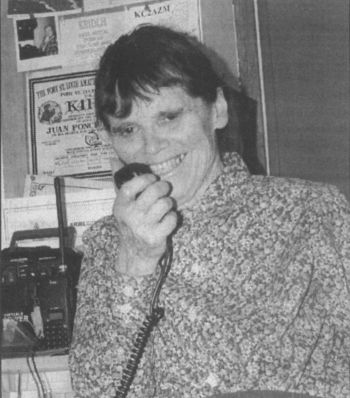| By Andrew Birden
FORT KENT - "I bake cookies for them."
That's how Gale Flagg, coordinator for the amateur radio operators for the Can-Am Crown dogsled race, said she is able to lure the 22 volunteers who fill in the final gaps in the communication network for the weekend competition.
Every year, Gale makes enough cookie dough to bake 30 dozen cookies, which she sends with her radio operators, also known as hams, when they spread out across the length and breadth of the race.
Those oatmeal chocolate chip cookies go a long way.
Many people will recognize Gale Flagg's name because she is the regular author of the Nature Column, featured in this newspaper. She is not only a celebrated naturalist, educator, cat enthusiast and community advocate. She is a problem solver.
In the St. John Valley, the choice between Sprint, AT&T and Verizon has little meaning, because no communications giant adequately covers this rural community. Consequently, folks who wish to live up here have learned to deal with a lack of telephone service to large regions west of Route 11.
For the Can-Am, this is especially important because race organizers, human personnel that follow the sled teams, and even the spectators rely on the ham radio operators to keep everyone in communication.
Flagg tells stories about working as a Can-Am ham.
She speaks of the time she and Ruth Schenk drove out to the distant Maibec checkpoint.
She said that one year the snow was so deep in the road that the car Ruth drove sent a spray of snow up and over the windshield.
Flagg said, "Ruth had to drive leaning out the window so she could see."
In another story, she describes how the hams worked together to help a musher who was in trouble and suffering from frostbite. "We had to coordinate his rescue."
On Saturday, Flagg will send pairs of her ham volunteers out to the various checkpoints, beginning with Portage.
By Sunday morning there will be ham operators stationed at Portage, Rocky Brook, Maibec,
and the Two River's Cafe in Allagash. Others will operate mobile units from their vehicles, and there will always be a few at the main station in Fort Kent.
If someone needs medicine at the Maibec checkpoint, the checkpoint ham sends the request across the invisible network of electromagnetic waves, through tall repeater towers (one on Flagg Hill in Fort Kent and the other on Rocky Mountain in Allagash) to Can-Am Central at Lonesome Pine Ski Lodge.
|
Once the organizers at Can-Am Central receive the message, they can arrange for the next person heading towards Maibec to deliver the medicine.. .or coffee, if that is the vital piece of equipment someone forgot to bring.
Flagg said, "Once everything settles down, they're transmitting when the teams come in and leave."
The hams originate from the local community, Presque Isle, and as far south as Augusta. They consist of four women and 18 men.
Flagg, a veteran of the first CanAm race, said she became interested in ham radio when she started working with other organizers for the race.
She said, "After I saw what the ham radio operators did, I said, `I'm going to get my license."'
By 1995, Flagg was tapping out Morse code at 20 words per minute, keeping a logbook of her time on the air, and spouting radio jargon like a pro.
What did it take to get her license?
"Study - lots and lots of study."
Flagg said the work she puts into her hobby has been worth it. "Through my ham radio, I've talked to people in Michigan and Puerto Rico."
She said that by harnessing her 100 watt radio to the Internet, she is able to talk to other hams across the entire planet.
She is proud to be a member of the community of hams. She said they are a special segment of our population. "They like to talk," she said, and after laughing, she added, "Most of them are interested in public service."
During the race, the hams in each pair trade the radio chair and the bunk between each other as they make sure someone is available during the entire race.
As the mushers move through the 250-mile course, the volunteers stay at their stations until the last musher is past the halfway marker to the next checkpoint.
The race may begin on Saturday, but in Allagash, the final hams don't leave until the following Tuesday.
Flagg said she admires the community of ham radio enthusiasts. "Most hams like to help out whenever they can."
This week will be busy for Gale Flagg as she finishes her preparations for the radio network. The preparations include organizing the equipment and also the people who volunteer.
"They have a good time, and they get cookies."
|


